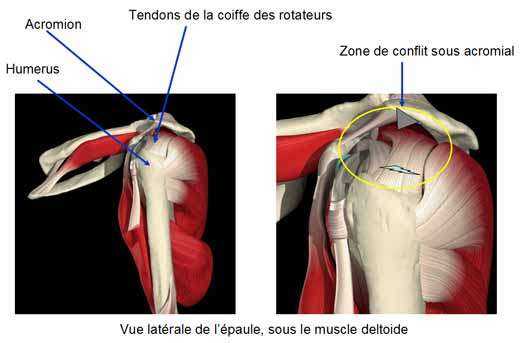Sub-acromial conflict or Subacromial impingement
Sub-acromial conflict refers to the irritation or partial rupture of the rotator cuff tendons caused by the rubbing of these tendons below the acromion during normal everyday gestures.
Definition
Sub-acromial conflict refers to the irritation or partial rupture of the rotator cuff tendons caused by the rubbing of these tendons below the acromion during normal everyday gestures.
This abrasion causes pain especially when the arm is raised to the side above the horizontal, making repetitive work in this position or even sleeping on the side difficult.
The causes are:
- The accumulation of repetitive gestures using the shoulder due to a sports activity, or a job necessitating this type of movement, or repetitive DIY-type gestures.
- An accident resulting in a partial rupture of the tendons
- The anatomic shrinking of the sliding space of the tendons below the acromion due to curvature of the acromion or the development of an arthrosis-linked phenomenon leading to the formation of bone, also called osteophytis.
The stages in the conflict develop from an increase in pain to the eventual rupture of the tendons.

DIAGNOSIS
Diagnosis is made during examination and carried out by the practitioner who questions the patient and performs testing movements on the shoulder.
Complementary examinations are generally necessary with X-Rays, arthro-scanner, MRI or echography
TREATMENT :
Medical treatment: this is proposed from the onset and is usually sufficient in cases diagnosed early or in the beginning stages. Medical treatment combined with rest and complete avoidance of the aggravating movements, regular physiotherapy which can last several months and possibly one or several intra joint infiltrations of a cortisone derivative.
Extra corporal shock wave treatment may also be proposed.
Arthroscopic surgical treatment: this treatment is proposed when medical treatment has failed. It consists of the mechanical elimination of the zones affected by the rubbing against the tendon, a cleaning process and ablation of the inflammatory tissues. Nowadays, arthroscopy is proposed almost systematically, rather than traditional open surgery.
ARTHROSCOPIC SURGICAL OPERATION :
- Length of hospital stay: approximately two days
- Anaesthetic: general or occasionally regional, depending on the patient and advice from the anaesthetist
- Immobilisation: arm in a sling for one week
2 or 3 holes of about 1cm are realised enabling the surgeon to insert a camera system and miniature instruments.
After complete exploration of the joint, cleaning and excision of all of the inflammatory tissues, ablation of the sub acromial impigment caused by the thinning of the acromion is performed using a burr which will recreate sufficient space for sliding with less friction at the rotator cuff tendons, allowing for them to heal within a few months.
The tendon of the long biceps, i.e. one of the two fixation tendons of the biceps, may be severed if it is worn down and causing pain.
In this case, the biceps may sometimes appear to be lower and more « rounded/ball-shaped » on the arm, without this affecting strength or ability to undertake everyday activities. The various incisions are closed with resorbable wire.
After-operation care: dressings are redone every two days in the patient’s home, ideally by a nurse. The wearing of a sling to immobilise the arm is recommended for one week before the patient is able to resume his everyday activities. Physiotherapy should be commenced after two weeks with about three sessions per week for an average of one to three months.
A patient may return to work after a few days where this work is of a sedentary nature, or after several months where the work is physical and involving shoulder movements. In general sports activities involving the shoulder may not be resumed before forty five days or longer depending on the initial lesions. The patient may return to driving after a minimum of eight days after the operation.
Pain : persistent, often lasting several months following the operation. Improvement is to be expected after three to six months due to the time necessary for the scars to heal after elimination of the bone conflict. Depending on individual cases, residual pain may persist.
COMPLICATIONS :
Arthroscopy is a surgical procedure, therefore complications are always possible even if, on the whole, rare.
- Algoneurodystrophy : may develop as with all operations, and is manifested through a stiff, painful shoulder developing over several months or even years. It is not possible to predict its occurrence or the stiffness left as an after effect and pain is therefore a possibility.
- Infection : Septic arthritis. This rarely occurs but it remains a possibility and may then require an adapted treatment or further surgery. -Haemarthrosis. i.e. the apparition of an effusion of intra-joint bleeding, possibly requiring further surgery -Inflammatory scarring. Depending on skin-type Stiffening of the shoulder, which can take several months to regress or else persist depending on the individual case
- The breaking of instruments inside the joint: the instruments used in an arthroscopy are fragile ; parts of them may break off and a further operation may necessary to remove the remaining fragments.
- Nerve-related complications, with the development of a loss of sensitivity or tingling sensations in some cutaneous zones – this is rare, but remains possible.
- pain may persist for several weeks or months or even indefinitely depending on the extent of the initial lesions. In general, this discomfort is less strong than that experienced prior to the operation.